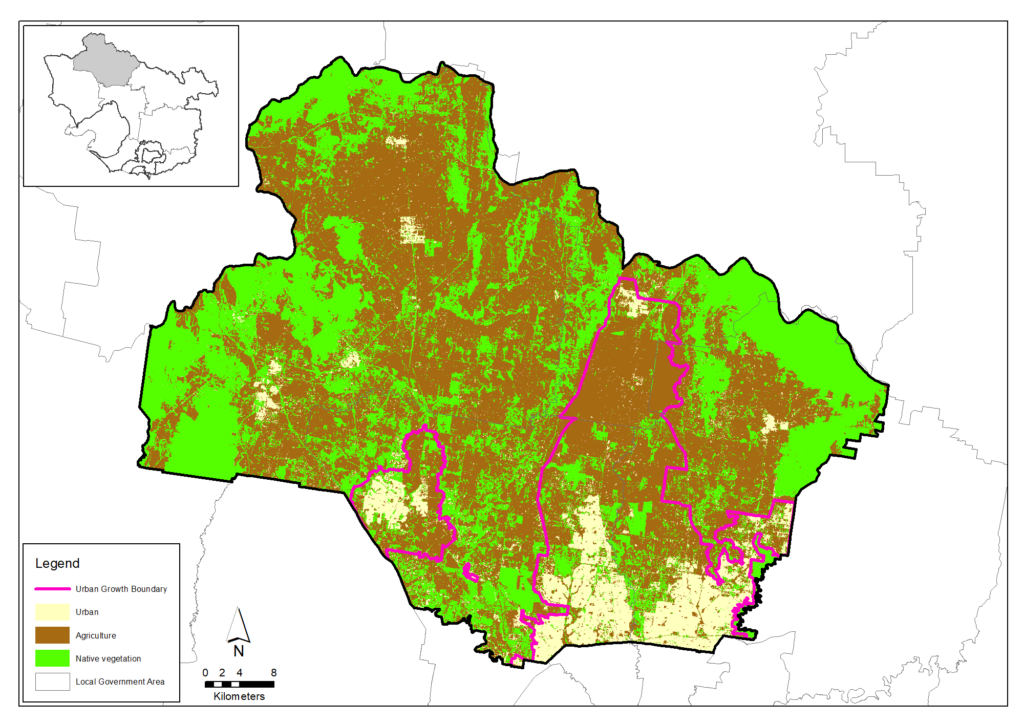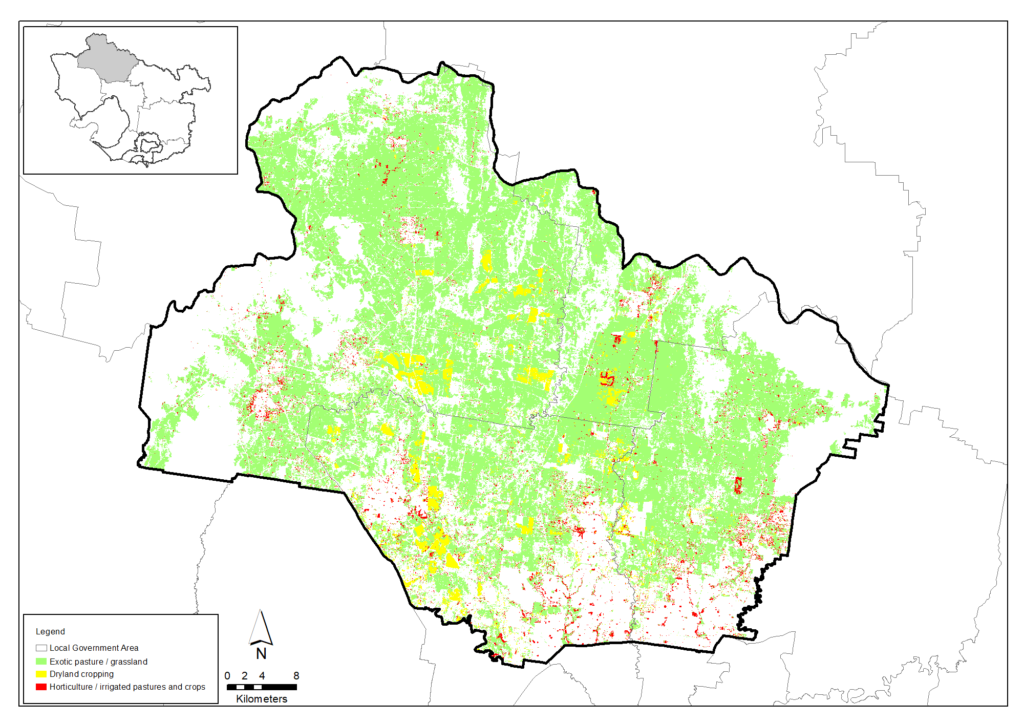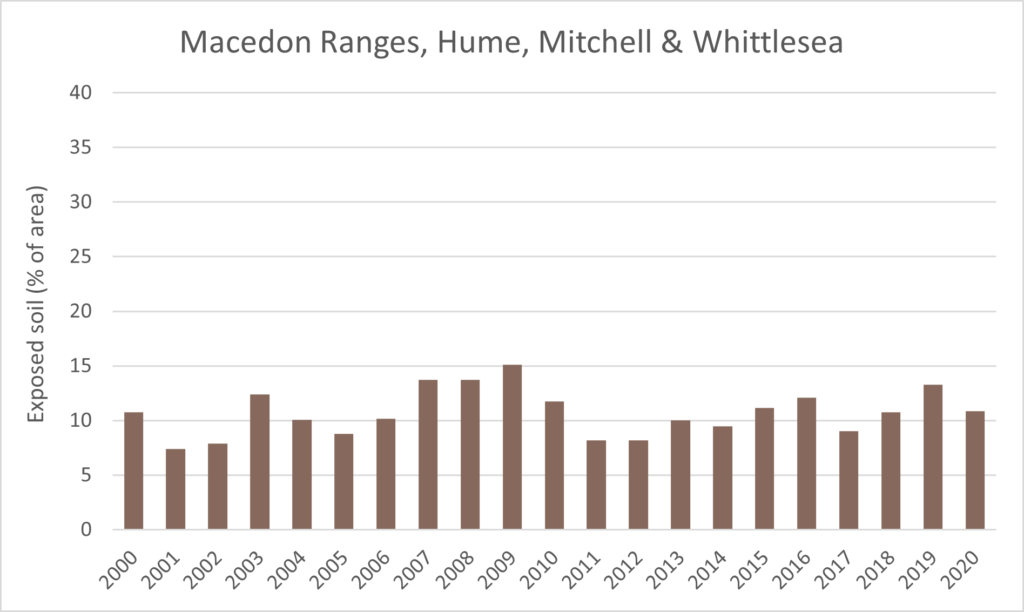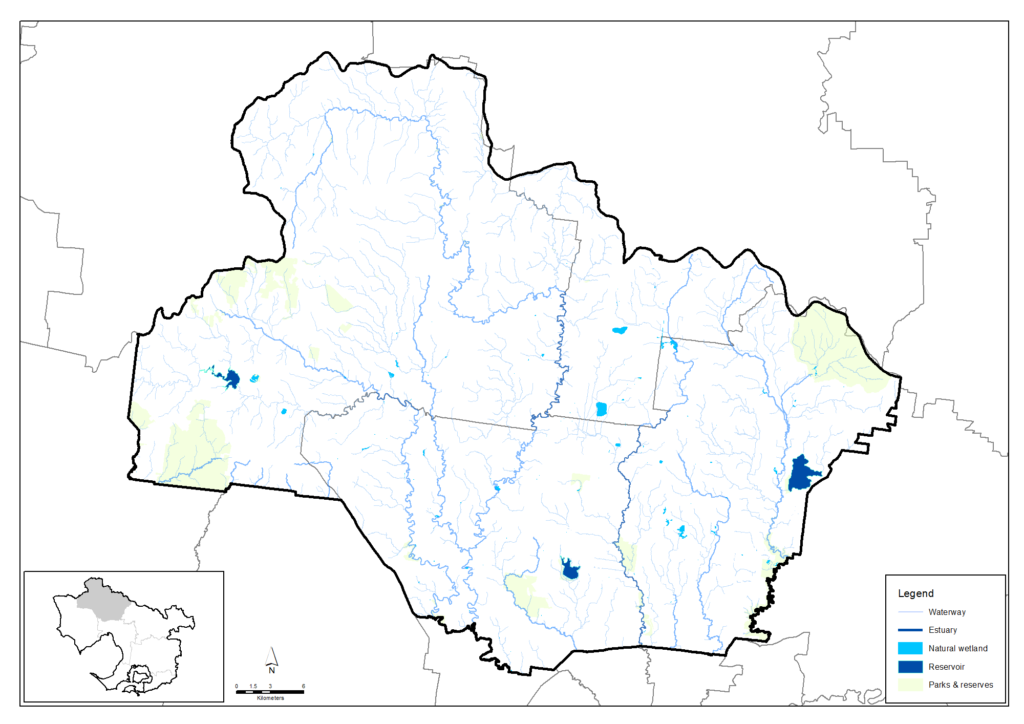Plains, valleys, ranges, city, country and everything in between
This area includes large expanses of rural land, forested ranges, river valleys and highly urbanised areas.
The southern slopes of the Great Dividing Range define the northern part of the area. State and regional parks here at Macedon, Lerderderg, Cobaw-Lancefield and Kinglake are critical nature conservation areas and the sources of Maribyrnong River, Jacksons Creek and the Plenty River. On the lower lopes and plains, there are native grasslands of National and State significance and River Red Gum Grassy Woodland. There is habitat for threatened native animals including the swift parrot, growling grass frog, greater glider and brush tailed phascogale.
However, there are demands for urban development, transport and infrastructure which compete for space and co-existence with nature. In the south and east, the growth corridors are Melbourne’s fastest growing residential, industrial and commercial suburbs. The population is predicted to grow by 67% to 783,000 by 2041. The area is a major transit hub for the state with the Melbourne International Airport, the Melbourne-Sydney rail corridor and major road routes including the Tullamarine Freeway, Western Ring Road, Hume Highway and Calder Freeway.
Urban growth’s wider effects are changing rural land use and agriculture on the northern margins of the region away from broad-acre grazing to higher value-per-hectare production and rural-residential uses.
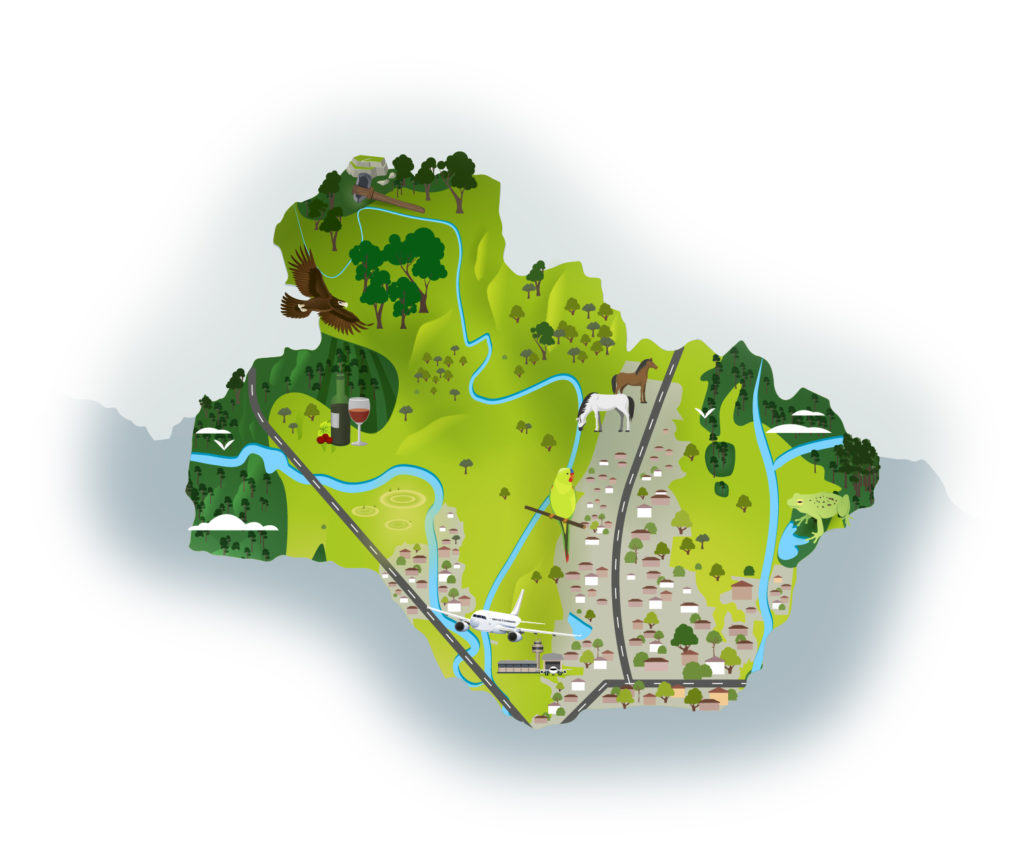
The condition of our environment now
Wurundjeri Country
This area to the north-west of Melbourne is Kulin Nation country. Archaeological evidence at the Murrup Tamboore site north of Melbourne shows the land, coasts and waterways of the Port Phillip & Western Port region were supporting Aboriginal people at least 31,000 years ago. The Sunbury Rings are a heritage site of national significance.
The Wurundjeri Woi Wurrung Cultural Heritage Aboriginal Corporation is recognised as the Registered Aboriginal Party, primary guardian, keeper and knowledge-holder for Aboriginal cultural heritage and Country in the area. They continue the modern movement by Traditional Owners to practice and strengthen their culture and care for Country.
Land use
The area covers 221,779 hectares. About 38 per cent of the catchment retains its natural vegetation, 54 per cent is used for agriculture and 8 per cent is urban.
Over the past 30 years, the urban area has increased by over 80% from close to 10,000 hectares to almost 18,000 hectares. There has been a corresponding decrease in the area of agriculture (down from around 126,000 hectares to 120,000 hectares) and native vegetation (down from around 86,000 hectares to 84,000 hectares). Further information on the change in area of various land uses over time can be found in the Land Use data table.
As mentioned, there has been significant urban development in the southern parts of this area as Melbourne has expanded north. Further urbanisation is expected in the decades ahead within the Urban Growth Boundary.
Population forecasts for the Macedon Ranges, Hume, Mitchell & Whittlesea area predict growth from an estimated 543,000 in 2021 to perhaps 970,000 in 2041.
The number of new dwellings is predicted to double in number across the Macedon Ranges, Hume, Mitchell & Whittlesea area from 155,600 in 2016 to 322,100 by 2041.
The continued urbanisation and population growth is expected to affect the health of waterways, biodiversity and land in the area.
Predicted population and dwelling increases in the Macedon Ranges, Hume, Mitchell & Whittlesea area
| Population 2021 | Population 2041 | Dwellings 2016 | Dwellings 2041 | |
| Macedon Ranges * | 33,300 | 89,600 (to 2036) | 11,400 | 17,400 (to 2036) |
| Hume | 249,000 | 372,600 | 68,100 | 128,400 |
| Mitchell * | 19,000 | 120,000 | 4,600 | 39,500 |
| Whittlesea | 242,000 | 388,400 | 71,500 | 136,800 |
| TOTAL | 543,000 | 970,600 | 155,600 | 322,100 |
* These forecasts consider the Macedon Ranges Shire’s five main centres in the Port Phillip & Western Port region (Gisborne, Riddells Creek, Romsey, Lancefield and Mt Macedon) to 2036 and the Mitchell Shire’s two main urban growth centres in the region (Wallan and Beveridge).
Agriculture
Agriculture occupies 120,005 (54%) of the area. Commodities valued at $116 million were produced by 500 enterprises in 2015-16.
Cattle grazing is the dominate use of land in area, but its relatively low per-hectare returns are leading a rapid transition to more intensive and niche enterprises such as free-range eggs, viticulture, fruit and horticulture.
Vegetables accounted for over $75m (91%) of total agricultural output in the City of Whittlesea in 2015-2016. Nursery production, cut flowers and nut growing matched the returns from livestock in the same period.
Off-farm incomes are growing components of peri-urban farm economies. Almost one third of respondents to 2013 research in the Macedon Ranges Shire said they drew 90% or more of their income from non-farm activities. Nearly two-thirds said they drew some off-farm income.
Agricultural land use declined sharply in the Northern Metropolitan Region from 46% to 26% of land area between 2006 and 2010. It was displaced, almost hectare-for-hectare, by residential development. Agriculture’s share of employment was one of only two sectors in decline in the Northern Metropolitan Region during the period 2006-16.
| Agriculture data from 2015-16 | Macedon Ranges, Hume, Mitchell & Whittlesea |
|---|---|
| Area of Macedon Ranges, Hume, Mitchell & Whittlesea (Hectares) | 221,779 |
| Area of agriculture (Hectares) | 120,005 (54%) |
| Number of farms | 500 |
| Employment on farms | 2,189 |
| Gross value of annual agricultural production ($) | $116 million |
| Main agricultural commodities | Beef, vegetables |
Rising land prices, declining access to water, weed and pest management constraints, land regulations and farm infrastructure decline are changing the viability of broad-acre grazing and cropping in the area.
Groundwater is currently a minor agricultural and urban resource in the Macedon Ranges Hume Mitchell Whittlesea area. 282 megalitres were extracted from the Lancefield Groundwater Management Unit in 2018-19; well below the licensed limit of 1,485 megalitres. This water is estimated to have supported production valued at $700,000.
Soil health
Over the whole area, the proportion of exposed soil has been below 15% for all years since 2000, and mostly around 10%, which is a relatively low level and indicates that most of the land remains covered and protected by vegetation (including pasture) at all times.
Proportion of exposed soils for the area from 2000 to 2020 (data from Australian National University)
Water, waterways and wetlands
The Maribyrnong River, Jacksons Creek, the Plenty River and the Merri, Darebin, Edgars and Bunjil Creeks flow from the area’s boundary on southern slopes of the Great Dividing Range.
The Yan Yean and Greenvale Reservoirs store water diverted from streams outside the region for supply to Melbourne’s metro area. The Rosslyne Reservoir near Gisborne stores water from the Lerderderg River for domestic supply to Sunbury and Gisborne and for diverters along the Maribyrnong.
Rivers and wetland conditions and conservation strategy for the area are described in the Maribyrnong and Yarra catchment chapters of the Healthy Waterways Strategy. Springs and soaks are also important natural wetland features in the Victorian Volcanic Plain. Moderate to low ratings have been determined as averages for key environmental values and waterway conditions across the Maribyrnong catchment. Yarra catchment waterways are in generally better environmental and physical condition. The best conditions are found in rural and forested reaches of streams on the southern slopes of the Great Divide.
Assessment of waterway values and conditions in the Maribyrnong catchment at 2018 (from the Healthy Waterways Strategy)
| Waterway values | 2018 state | 2018 trajectory | 2068 target |
|---|---|---|---|
| Birds | Moderate | Moderate | Moderate |
| Fish | Low | Low | Moderate |
| Frogs | Moderate | Low | Moderate |
| Macroinvertebrates | Moderate | Low | High |
| Platypus | Moderate | Very low | Moderate |
| Vegetation | Low | Very low | Moderate |
| Amenity | High | Moderate | High |
| Community connection | High | Moderate | Very high |
| Recreation | High | Moderate | Very high |
| Waterway conditions | 2018 state | 2018 trajectory | 2068 target |
|---|---|---|---|
| Stormwater | Moderate | Moderate | High |
| Physical form | Moderate | Low | Moderate |
| Water for the environment | Moderate | Low | High |
| Vegetation quality | Moderate | Low | Moderate |
| Vegetation extent | Low | Low | High |
| Instream connectivity | Low | Low | Moderate |
| Water quality - environment | Moderate | Low | Moderate |
| Access | Low | Low | Moderate |
| Litter | High | Moderate | High |
| Water quality - recreational | High | Moderate | High |
| Participation | Moderate | Low | Very high |
Biodiversity
Native vegetation covers about 84,000 hectares (38%) of the area. This vegetation is concentrated in some landscapes while little remains across large parts of the area.
The largest and most intact conservation reserves in the area are Lerderderg State Park (total area 20,500 hectares), Macedon Regional Park (2,100 hectares), a small part of Wombat State Forest (2,000 hectares), Cobaw-Lancefield State Forest (1,700 hectares), Woodlands Historic Park (820 hectares), Mount Disappointment State Forest (1,600 hectares), the majority of Kinglake National Park (12,000 hectares) and Plenty Gorge Parklands (940 hectares).
Nature conservation reserves managed by the four councils are additional and valued patches of native vegetation. Most are relatively small and scattered across cleared landscapes but potential ‘stepping stones’ in revegetation projects to improve habitat connectivity.
Diverse ecosystems host a wide range of native plants and animals. The biodiversity and conservation potential of the area is strongly supported by its diverse land and vegetation types, altitudes and micro-climates.
| Proportion of area with native vegetation | Current cover (hectares) | Area protected on public land (hectares) | |
| Macedon Ranges | 35% (estimate) | 30,000 (estimate) | 18,300* |
| Hume | 24% | 12,000 | 2,200 |
| Mitchell | 20% (estimate) | 3,600 (estimate) | 1,600* |
| Whittlesea | 35% | 17,000 | 4,860 |
Native vegetation cover remaining in the local government areas of Macedon Ranges, Hume, Mitchell & Whittlesea (* Parks Victoria properties only. Mitchell Shire bushland reserves not listed in published data. The whole Macedon Ranges Shire contains 20 bushland reserves totaling 517 hectares.)
Fauna species were surveyed for the Hume City Council Fauna Survey Program across 17 Council-managed reserves in 2015-2016. The survey found 132 bird, 29 mammal, 12 reptile, 10 frog, 8 fish and 2 invertebrate species.
The Shire of Macedon Ranges Biodiversity Strategy 2018 describes rich faunal diversity across the shire including many species which are threatened or endangered. The strategy notes that numerous native animals have disappeared from the Macedon Ranges Shire including the Southern Brown Bandicoot (last recorded in 1968), Leadbeater’s Possum (last recorded in 1995) and the Eastern Quoll (last recorded in the late 1800s). The Greater Glider is known in the Wombat Forest but has not been recorded on Mount Macedon since 1987. The Council has in place a long term biodiversity monitoring program that utilizes woodland birds, arboreal mammals and greater gliders/powerful owls as indicator species of ecosystem health. It engages local community members as citizen scientists and all findings are uploaded to the Victorian Biodiversity Atlas
The Mitchell Shire Environment Strategy 2014-2024 lists 19 species of threatened flora and 45 species of threatened fauna found in the shire.
The City of Whittlesea Biodiversity Strategy 2019-2029 lists 64 threatened fauna and 47 threatened flora species recorded in its area in the last 30 years. The strategy also lists 6 threatened ecological communities listed by the Victorian Flora and Fauna Guarantee Act 1988 and/or the Australian Government EPBC Act 1999.
An overall picture of decline in native animal species in response to habitat loss, pest predation and other factors is indicated in an analysis of animal sighting data that calculated the probability that each species of native birds, mammals, amphibians, reptiles and fish was persisting at the end of 2016.
The analysis indicated that, for the Macedon Ranges, Hume, Mitchell & Whittlesea area, only around 78% of the total number of species recorded here are still persisting. In general, the diversity of native fish and reptile species seem to have been most affected.
| Native species | Number and proportion of species likely to be persisting (at 2016) |
|---|---|
| Birds | 235/279 (84%) |
| Mammals | 32/43 (74%) |
| Amphibians | 13/16 (81%) |
| Reptiles | 21/34 (62%) |
| Fish | 18/20 (25%) |
| Total | 306/392 (78%) |
Threatened species are considered to be priorities for local protection and recovery work. In many circumstances, work to protect and enhance their health and resilience will also benefit other native animal species and the local habitat. The following table shows some of the threatened species and ecological communities that have been recorded in this area. A full list of the threatened species known to occur in this region since 1980 is available at the Data tables section of this strategy.
Threatened species known to occur in the Macedon Ranges, Hume, Mitchell & Whittlesea area
| Group | Species |
|---|---|
| Birds | Australasian Bittern, Australian Little Bittern, Barking Owl, Black Falcon, Blue-billed Duck, Brolga, Caspian Tern, Diamond Firetail, Eastern Great Egret, Freckled Duck, Lewin's Rail, Little Egret, Magpie Goose, Plumed Egret, Powerful Owl, Speckled Warbler, Swift Parrot, White-bellied Sea-Eagle, White-throated Needletail |
| Mammals | Eastern Barred Bandicoot, Brush-tailed Phascogale, Eastern Bent Winged Bat, Grey-headed Flying-fox, Platypus |
| Amphibians | Brown Toadlet, Growling Grass Frog, Southern Toadlet |
| Reptiles | Lace Monitor, Tussock Skink |
| Fish | Yarra Pygmy Perch |
| Invertebrates | Amethyst Hairstreak Butterfly |
| Flora | Bacchus Marsh Wattle, Basalt Pepper-cress, Black gum, Clover Glycine, Curly sedge, Fairy Lanterns, Hairy-leaf Triggerplant, Hoary Sunray, Large-flower Crane’s-bill, Large-fruit Yellow-gum, Large-headed Fireweed, Matted Flax-lily, Plains Rice-flower, Salty Paperback, Silver Gum, Small Scurf-pea, Sunshine Diuris , Swamp Everlasting, Tough Scurf-pea, Large-flower Crane's-bill |
| Ecological communities | Grassy Eucalypt Woodland of the Victorian Volcanic Plain, Grey Box (Eucalyptus microcarpa) Grassy Woodlands and Derived Native Grasslands of South-eastern Australia, Natural Temperate Grassland of the Victorian Volcanic Plain, Seasonal Herbaceous Wetlands (Freshwater) of the Temperate Lowland Plains, White Box-Yellow Box-Blakely's Red Gum Grassy Woodland and Derived Native Grassland, Cool Temperate Mixed Forest, Cool Temperate Rainforest, Grey Box - Buloke Grassy Woodland Community, Limestone Grassy Woodland, Rocky Chenopod Open Scrub, Western (Basalt) Plains Grasslands, Western Basalt Plains (River Red Gum) Grassy Woodland |
Community action
There is a vibrant Landcare movement across the Macedon Ranges, Hume, Mitchell & Whittlesea area. There are 10 active Landcare Groups and two Landcare Networks. Based on data from a 2019 survey, it is estimated that the groups and networks collectively have around 477 members and volunteer around 11,413 hours per year for Landcare activities that benefit the environment, landscapes and community. This volunteering is worth in the order of $384,732 per year.
Community volunteers are also active in numerous Friends groups, Committees of Management and other volunteer organisations across the sub-region. There are an estimated 21 organisations providing 4,740 volunteer hours worth $159,785 per year.
More detail is in the Community volunteering data table.
The Shire of Macedon Ranges Biodiversity Strategy also maps around 70 Trust for Nature and Land for Wildlife properties in the part of the shire that is in this region.
Challenges we face
Climate change, population pressures and urbanisation are among the major challenges to the future health of environments in the Macedon Ranges, Hume, Mitchell & Whittlesea area.
Climate change
The Climate Change in the Port Phillip & Western Port Region report identifies risks and responses to warmer, drier conditions and rising sea levels across the region.
The most climate-sensitive and affected environmental assets in the Macedon Ranges. Hume. Mitchell & Whittlesea area are predicted to be:
- large areas of native vegetation in Macedon, along the Great Divide north of Cobaw, Lancefield and Whittlesea
- native vegetation in the valleys of the upper Deep Creek and Merri Creek and in conservation reserves at Woodlands and Jacksons Creek
- riparian and in-stream habitats in the upper reaches of Deep Creek and Moonee Ponds Creek
- numerous freshwater wetlands, particularly at Kalkallo, Wallan and Beveridge
- soils on steeper slopes along the Great Divide around Macedon and south through Gisborne to Toolern Vale
- soils in the Deep Creek catchment and on the hills north and east of Whittlesea where erosion risk is increased by climate-induced vegetation loss and more frequent intense fire.
The urban heat island effect will be an issue for Melbourne. Current development of growth areas to support Melbourne’s future population will see more people exposed to extreme urban heat levels and significantly increase the number of heat-vulnerable communities.
Climate Risk Assessments developed by the three Local Government-based Alliances for Greenhouse Action, the Eastern Alliance, the Northern Alliance and the Western Alliance find:
- Vulnerability to climate change is compounded for newly arrived migrants, the aged and young children and people living in relative poverty, in sub-standard housing or with poor English
- Lack of understanding of local flora and fauna species responses to climate change is hampering timely and effective investment and action for biodiversity conservation
- Social and policy pressures for larger fire breaks and more fuel-reduction burning is impacting biodiversity and air quality
- Changing wildfire frequency and intensity in warmer, drier conditions is damaging biodiversity and increasing demands for fire-management effort
- Fire agency management planning often conflicts with the environmental protection goals and targets of local, regional and state environment strategies.
Urbanisation and population growth
Population forecasts for the Macedon Ranges Hume Mitchell Whittlesea area predict growth of 56% over the next 20 years – from 543,000 in 2021 to 970,000 in 2041*. (* Population forecast data for Macedon Ranges Shire is limited to the 2021-2036 period)
The urbanisation effect of population growth on land, waterways and biodiversity is suggested in forecasts for the construction of new dwellings. These are predicted to double in number across the Macedon Ranges Hume Mitchell and Whittlesea area from 155,600 in 2016 to 322,100 by 2041.
Significant urban development and population growth is forecast for this area and is likely to bring:
- demands for space, facilities, transport infrastructure and access to recreation areas
- damage from illegal clearing, vehicle tracks, vandalism, feral animals, firewood collection and rubbish dumping
- altered stream flows and water pollution from increased hard-surface run-off
- waterways habitats damaged by flood protection works and sediment inputs
- barriers to animal movement created by roads and infrastructure
- continuing habitat damage from recreation, vandalism, informal vehicle tracks and rubbish
- continued clearing for buildings, fences, access, views etc.
- feral domestic animals
- pest plants and plant diseases such as Phytophthora cinnamoni spread by humans, birds and animals and from dumped garden waste.
Green Wedge protection
Preserving Melbourne’s Green Wedges, rural and semi-rural land outside the Urban Growth Boundary, is likely to cause ongoing social, economic and political tension. Urban and rural land uses and priorities, residential amenity and farm business activities often conflict at Green Wedge boundaries.
Farming becomes more difficult and economically challenging as new suburbs butt up against farm fences. Selling and subdividing peri-urban farmland is an attractive economic choice for ageing and/or cash-poor farmers. Many see few better options than this ‘last harvest’. Land just outside the Urban Growth Boundary is often left vacant or poorly managed in ‘land banks’ as owners await and/or lobby for rezoning and subdivision.
Victorian Government policy is to protect Green Wedges from urban development and inappropriate uses. Persistent commitment to this policy will be needed from local councils, State Government and its agencies to protect it from gradual erosion through piecemeal exemptions.
Pest plants and environmental weeds
Pest plants and environmental weeds are a major threat to the area’s natural environment and to its agricultural enterprises. Once established, they grow vigorously because they have few natural predators or diseases to control them. They change and destroy habitats and ecosystems, outcompeting indigenous plants for light, nutrients and water. This leaves our wildlife without food and habitat, leading to the decline of our native animals. In addition to various listed weed species that remain priorities for control, Texas needlegrass and lobed needlegrass are examples of unlisted weeds that pose growing threats.
Many pest plants are spread from domestic gardens. Seeds are spread by birds and animals or by people dumping garden cuttings into our bush and waterways.
Pest animals and predators
The introduction of exotic plants and animals has had significant consequences for the area’s native animal and plant species.
Pest animals impact on native plants, animals and their habitats. Increasing populations of feral deer pose significant biodiversity and biosecurity threats while fox and feral cat predators are primary causes of native animal declines and extinctions.
Other pest animals including rabbits directly compete with native wildlife for food and shelter, damage native vegetation and degrade the land, while introduced fish species compete for food and prey on native fish, tadpoles and frogs.
Changing fire regimes, frequency and intensity
Traditional Owners have used fire as an ecological management tool for more than 40,000 years, understanding that Australian plant and animal communities rely on ‘regimes’ of fire intensity, frequency, season, extent and type to regenerate and maintain health and diversity. Fire regimes create food, shelter and breeding sites for native animals.
Changing fire regimes caused by climate change and human intervention through the 20th Century means some native plant and animal communities have been unnaturally insulated from fire, while others have been exposed to more frequent burning.
A drier future climate will increase the likelihood more frequent and severe wildfire, like those experienced across south east Australia in the summer of 2019-20 where an estimated 1 billion native animals were killed.
Incremental damage and clearing of native vegetation
Incremental damage to the area’s native vegetation has been caused by illegal clearing, vandalism, informal vehicle tracks, firewood collection and rubbish dumping. Incremental clearing at the edges of remnant patches and of individual trees is expected to continue. Some losses will prompted by wildfire control, others for future residential development.
Native vegetation loss across the Macedon Ranges Hume Mitchell Whittlesea area is likely to continue species decline. The 2004 biodiversity study, How much habitat is enough? showed that landscapes with less than 15% vegetation cover may support diverse but low populations of native plant and animal species, but their future is not assured. The study recommends that increasing vegetation cover above 15% could be an intermediate revegetation goal while 35% cover should be a goal where practicable.
Barriers to nature conservation policy and strategy on the urban edge are discussed in the City of Hume’s Land and Biodiversity Plan 2015-2019 and other council and authority plans. It lists and explores:
- development pressure
- habitat loss and fragmentation
- climate change
- waterway and wetland degradation
- erosion
- weeds
- pest animals
- inappropriate land management
- lack of knowledge of cultural heritage values
- lack of knowledge of local fauna populations
- lack of community connectedness to nature.
Supporting Wurundjeri Woi-wurrung connection with Country
There is a challenge to strengthen the role and influence of traditional ecological knowledge and practices in today’s natural resource management programs, where that is allowed and offered by Traditional Owners.
There are currently relatively few Aboriginal people who have jobs taking care of Country in this region, with the exception of some outstanding examples such as the Wurundjeri Narrap Team. There is a challenge in providing timely, tailored support for Registered Aboriginal Parties and other Aboriginal organisations so they can determine their aspirations and build their workforce to suit their aims with the appropriate range of skills.
Traditional Owners’ rights to water have largely been excluded from water planning and management policies and programs. Without water rights, Traditional Owners are unable to decide where or how water can be used to support cultural, spiritual, environmental or economic outcomes. There is an opportunity to address this in water planning and securing water allocations for Registered Aboriginal Parties to enable cultural watering.
Policy and planning
A range of policies and plans are in place to protect and enhance the area’s cultural, social, environmental and economic values and address the challenges that lie ahead.
Plan Melbourne 2017-2050 is the main integrated land-use, infrastructure and transport plan published by the Victorian Government. It aims to support economic growth and protect liveability and sustainability across metropolitan Melbourne. As part of its implementation, Land Use Framework Plans are being developed to guide strategic land-use and infrastructure development for the next 30 years for six metropolitan Melbourne regions including the Northern region (comprising the Banyule, Darebin, Hume, Mitchell, Moreland, Nillumbik and Whittlesea Local Government Areas).
For Melbourne’s urban growth areas, the Victorian Planning Authority manages the development of Precinct Structure Plans (PSPs) which are master plans for local areas that usually cater for between 5,000 to 30,000 people, 2,000 to 10,000 jobs or a combination of both. PSPs provide more specific detail regarding how existing important features of local communities such as roads, shopping centres, schools, parks, key transport connections and areas for housing and employment may evolve or transform over time and become better integrated.
The management of land, water and biodiversity in the Macedon Ranges, Hume, Mitchell & Whittlesea area is principally overseen by its four councils, Melbourne Water, Parks Victoria, the Department of Energy, Environment and Climate Action and EPA Victoria along with landholders and other authorities, organisations and community groups. The area’s most significant strategies and plans include the:
- Hume City Council Land and Biodiversity Plan (2015-2019)
- Mitchell Shire Council Environment Policy 2020
- City of Whittlesea Biodiversity Strategy and Green Wedge Management Plan
- Macedon Ranges Shire Council Biodiversity Strategy and Environment Strategy
- Healthy Waterways Strategy 2018-28 which provides vision statements, goals and 10 and 50-year targets for waterway management in each of the region’s catchments
- Protecting Victoria’s Environment – Biodiversity 2037 – the Victorian Government’s state-wide strategy to arrest biodiversity decline.
For the Macedon Ranges, a particular Macedon Ranges Statement of Planning Policy has been put in place to ensure the outstanding and valuable landscapes, layers of settlement history, impressive landforms, diverse natural environment, catchments and biodiversity of the Macedon Ranges are protected, conserved and enhanced and continue to be of special significance to the people of Victoria
Climate Risk Assessments have been developed by the three Local Government-based Alliances for Greenhouse Action, the Eastern Alliance, the Northern Alliance and the Western Alliance.
Traditional Owners are the voice of their Country
For all policy and planning, there is a need for recognition and inclusion of Traditional Owner knowledge and aspirations. The waterways and lands are increasingly being recognised as ‘living and integrated natural entities‘ and the Traditional Owners should be recognised as the ‘voice of these living entities’. The Wurundjeri Woi-Wurrung Cultural Heritage Aboriginal Corporation is developing its Country Plan which will outline the Wurundjeri Woi-wurrung vision and priorities for Country and provide a strong basis for all planning to recognise and include the voice of these Traditional Owners.
Vision and targets for the future
Vision
The Traditional Owners of this area, the Wurundjeri Woi-wurrung people, have cared for this Country for tens of thousands of years. A vision for its future will be outlined in the Wurundjeri Woi-wurrung Country Plan (in preparation).
Municipal Council visions for biodiversity are:
Macedon Ranges
We have flourishing and connected communities of native plants and animals, plentiful and accessible natural places, and healthy and vibrant waterways across the Macedon Ranges.
Hume
The City’s natural heritage, environment and rural spaces are protected, enhanced, maintained and valued; Cultural heritage sites are identified, protected and effectively managed; and Suburbs are leafier with increased canopy cover.
Mitchell
A leader in sustainable environmental management in all our business operations and in support of the wider community
Whittlesea
Improve our knowledge and understanding of local biodiversity; strengthen the Planning Scheme to achieve better biodiversity outcomes; and support our rural landowners to protect biodiversity on their land
The Hume City Council Land & Biodiversity Plan 2015-2019 goals and targets for flora and fauna, heritage and urban tree cover are:
- the city’s natural heritage, environment and rural spaces are protected, enhanced, maintained and valued.
- cultural heritage sites are identified, protected and effectively managed
- suburbs are leafier with increased canopy cover
- native vegetation (in 2040) occupies an additional 6% of the non-urban landscape, resulting in 30% total vegetation cover.
- no flora or fauna species become extinct within Council-managed conservation reserves (to 2040).
- all cultural heritage sites are appropriately protected, managed and interpreted (where appropriate) (to 2040).
- canopy cover increase (in 2040) of 30% in car parks, 40% in open space, 25% in streetscapes and 15% on private land.
The Mitchell Shire Environment Strategy 2014-2024 targets include:
- protect, enhance and connect landscapes by increasing the extent and quality of native habitat.
- improve water quality, riparian condition and in-stream habitat of waterways and wetlands.
- conserve and improve quality productive farming land and rural landscapes.
- enable land use planning and development that respects and conserves Mitchell Shire’s natural environment by anticipating, avoiding and reducing potential adverse impacts from increased population, economic and settlement growth.
The Macedon Ranges Shire Council Environment Strategy targets and Biodiversity Strategy objectives include:
- protect and enhance the health, connectivity and extent of ecosystems across the Shire, and avoid any further loss of species and communities.
- continuously improve Council’s understanding of the Shire’s unique biodiversity, in its many contexts and complex interactions.
- utilise and promote best practice and evidence-based conservation management techniques to protect biodiversity and manage threats, taking into account local and expert knowledge
- protect existing biodiversity and native vegetation
- improve existing biodiversity and native vegetation across public and private land
- increase the extent of native vegetation cover for connectivity
- improve Council and the community’s understanding and connection to biodiversity
- enhance the capacity of community groups to undertake conservation activities
- develop a shire-wide biodiversity monitoring program that assesses the health of the broader ecosystem.
The City of Whittlesea Biodiversity Strategy 2019-2029 and Environmental Sustainability Strategy 2012-2022 objectives are:
- improve our knowledge and understanding of local biodiversity
- strengthen the Planning Scheme to achieve better biodiversity outcomes
- support our rural landowners to protect biodiversity on their land
- encourage awareness and participation in urban biodiversity and improvement
- manage Council land to reduce threats and improve habitat quality
- collaborate with other land management agencies
- maintain and improve ecological health of waterways
- maintain and improve rural land health and productivity
- greater community engagement and awareness in sustainable rural land management
- promote environmentally sustainable outcomes in urban development.
Regional Catchment Strategy targets
The following long-term targets for the Macedon Ranges, Hume, Mitchell & Whittlesea area (at the year 2050 or further) reflect the region-scale vision of the Regional Catchment Strategy and the visions and directions of the local councils, the Healthy Waterways Strategy, other plans and the community. Achievement of these targets will help ensure this area remains healthy for future generations. In some cases, the targets are the local contribution towards achieving whole-of-region targets outlined in the ‘Themes‘ section of this Regional Catchment Strategy.
Partner organisations for the journey ahead
The following organisations formally support the pursuit of the Regional Catchment Strategy’s targets for the Macedon Ranges, Hume, Mitchell & Whittlesea area. They have agreed to provide leadership and support to help achieve optimum results with their available resources, in ways such as:
- Fostering partnerships and sharing knowledge, experiences and information with other organisations and the community
- Seeking and securing resources for the area and undertaking work that will contribute to achieving the visions and targets
- Assisting with monitoring and reporting on the condition of the area.
Traditional Owners
Local Government
- Hume City Council
- City of Whittlesea
- Macedon Ranges Shire Council
- Northern Alliance for Greenhouse Action
Community
- Federation for Environment and Horticulture in the Macedon Ranges
- Upper Deep Creek Landcare Network
- Deep Creek Landcare Group
- Riddells Creek Landcare Group
- Newham and District Landcare Group
- Jacksons Creek EcoNetwork
- Greening of Riddell
- Friends of Emu Bottom Wetlands Reserve
- Friends of Daly Nature Reserve
- Merri Creek Management Committee
- Darebin Creek Management Committee
Victorian Government
- Department of Energy, Environment and Climate Action
- Melbourne Water
- Parks Victoria
- Sustainability Victoria
- Zoos Victoria
- Environment Protection Authority Victoria (EPA)
- Victorian Planning Authority
- Victorian Fisheries Authority
- Trust for Nature
- Victorian Environmental Water Holder
Non Government
- The Nature Conservancy
- Birdlife Australia
- Gardens for Wildlife Victoria
- The People and Parks Foundation
- Habitat Restoration Fund
- Conservation Volunteers Australia
- Native Fish Australia (Vic)
- OzFish Unlimited
- Field Naturalists Club of Victoria
Add your organisation as a supporter and partner
If your organisation supports these directions and targets for Macedon Ranges, Hume, Mitchell & Whittlesea, you can request to be listed as a partner organisation. Adding your organisation to this list will:
- enable your organisation to list one or more priority projects in the Prospectus which will describe how your priority project will pursue the targets of this Regional Catchment Strategy and potentially make your organisation’s project more attractive to investors by using the strategy to highlight its relevance and value
- demonstrate your commitment to a healthy and sustainable environment
- demonstrate the level of community engagement and support for this work.
Priority projects to move forward
Priority projects
There are significant ongoing programs and initiatives undertaken by many organisations that are vital for the management of natural resources and the support of communities in the Macedon Ranges, Hume, Mitchell & Whittlesea area. In addition, there are numerous project proposals that, if funded and implemented, can contribute to achieving the Regional Catchment Strategy’s visions and targets for the area. They include projects that:
- Establish new vegetation in large-scale, strategic locations where it provides multiple benefits by contributing to carbon sequestration, habitat restoration and habitat connectivity
- Help achieve net gain in the extent and condition of habitat across public and private land, coasts and waterways
- Protect waterways
- Protect threatened species
- Support soil health and the adoption of sustainable agriculture practices
- Support resilience to climate change in agricultural enterprises and communities
- Increase community participation, engagement, education and enjoyment in nature and conservation
- Strengthen Traditional Owners roles in environmental decision-making and action.
Project proposals include:
- Cobaw Biolink led by the Newham and District Landcare Group
- A Swift Response: Securing stepping stones of habitat for the Swift Parrot proposed Melbourne Water
- Growing Grassy Woodlands proposed by Macedon Ranges Shire Council
- Will-im-ee Moor-ing Biolink proposed by Macedon Ranges Shire Council
- Permanent protection for Barrm Birrm proposed by Macedon Ranges Shire Council
- Jacksons Creek cultural landscapes proposed by Melbourne Water
- EcoVineyards led by Retallack Viticulture
- Jacksons Creek & Emu Bottom Wetland Rabbit Control proposed Melbourne Water
- Jacksons and Riddells Creeks Wildlife Corridor proposed by Jacksons Creek EcoNetwork
- Deep Creek Biolink proposed by Upper Maribyrnong Catchment Group
- Merri Creek Biolink proposed by Merri Creek Management Committee
- Merri Creek Community Engagement led by the Merri Creek Management Committee
- Upper Merri Creek Sub-Catchment Plan proposed by Yarra Valley Water
- Westmeadows Meander proposed by the Chain of Ponds Collaboration
- Maribyrnong Valley Connection proposed by the Hume City Council
- Bunjil and Bandicoots on the Flight Path led by the Chain of Ponds Collaboration
- Ensuring the survival of Temperate Grasslands and Grassy Woodlands proposed by Hume City Council
- Practical Regenerative Agricultural Communities program led by Macedon Ranges Shire Council.
A list of project proposals and their key details can be viewed and sorted on the Prospectus section of this website.
Propose a new priority project
As part of the ongoing development and refinement of this Regional Catchment Strategy, additional priority projects may be considered for inclusion in the Prospectus.
If your organisation supports the directions and targets for this area, and has a project it would like highlighted and supported in this Regional Catchment Strategy, please submit a Prospectus Project Proposal.

